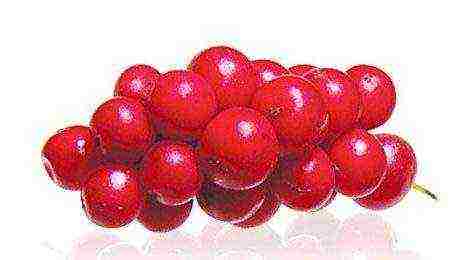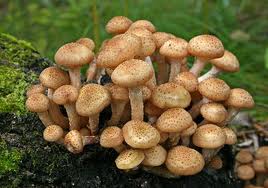Content [show]
Thanks to new technologies, gardeners receive not only high yields of strawberries, but also greatly simplify agrotechnical actions. One of the striking indicators is agrofibre... A crop planted on top of a canopy ripens much faster than a conventional planting in the ground, and the berries are always clean, despite the rainfall.
pros
- Weeds are excluded.
- Mustaches do not take root.
- Berry picking is made easier.
- Slugs do not appear due to the dry surface.
- There are no colonies of ants and other insects.
- Permeates air and water with fertilizers.
- Moisture is retained and watering is rarely done.
- Easy to mulch.
- Fruiting occurs earlier.
Minuses
- Installation costs.
- Over time, the new canvas will allow moisture to pass through well, but at the first stage, the water rolls into the grooves.
- Agrofibre dries for a long time after rain or watering, there is a possibility of berry rotting.
Required materials and tools 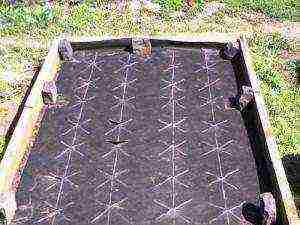 Preparation of the landing pattern
Preparation of the landing pattern
For work you will need:
- Shovel;
- Sharp knife;
- Wire for making hairpins;
- Agrofibre in rolls;
- Bricks or stones.
- Strawberry seedlings.
Preparing the beds
- A landing site is selected, preferably sunny.
- Marking is done for the garden.
- The shape can be made both rectangular and square.
- The width of the row can be any, but it is better to choose a convenient size so that the approach is from all sides on an outstretched arm.
- The distance between the beds is 1 m.
- The standard size of agrofibre is 1.6 m wide. If multiple lanes will be used, then it is worth considering the paths between the rows. It is good to use paving slabs for this.
- The material does not stick together during operation, but overlaps (20 cm).
-
 White agrofibre is better for southern regions
White agrofibre is better for southern regions
The soil is carefully dug up, as this is done for 3 years.
- Then fertilizers are added to each square. meter: Fertilizers containing nitrogen and potassium, 150 g each, 2 glasses of wood ash, 1 bucket of humus. In order to properly distribute the dressing, you need to mark the site with pegs at a distance of 1 meter from each other.
- Next, the soil is dug up again and leveled with a cultivator or garden rake.
- The bed can be high and on a flat surface. They need to be located from east to west. This will ensure uniform illumination.
- Suppose that the site occupies a large area, then it will be profitable to equip simple beds. Since the material will need to be cut into strips, and the remains should be thrown away. The site will also need to be leveled for subsequent transplantation for other crops.
- For northern regions and in places with a high level of groundwater, high beds would be the best option. Such regions include the Urals, Siberia, and the central part of Russia.
- After agrotechnical work, the canvas is laid. It can be of different density.
For strawberry seedlings, you need to take a density of 60 g / sq. m black. For the southern regions, it is better to purchase a white canvas with a density of 17 g / sq. m. It will perfectly protect the culture from the scorching sun rays and heavy rains.
- Studs (24 cm long) are made of wire, and they fix the agrofiber around the entire perimeter. Previously, the material is fixed with improvised means: stones, bricks.
Landing scheme
- Agrofibre stretches well.
- Then, you can go to the marking of the footprints.
- For this, a cord is used that is pulled along the beds.
- The step between the beds is 46-50 cm, the rows are 40, the bushes are 30. The distance from the edge of the row is 20 cm. The seats can be staggered if more than three lines are used.
- In the marked place for the sockets, cuts are made with a sharp knife, in a cruciform manner, with a distance of 5 cm from the center. The corners should be turned outward.
How to plant?
Once the beds are ready, you should proceed to mulching. Straw mixed with grass can be used as mulch.
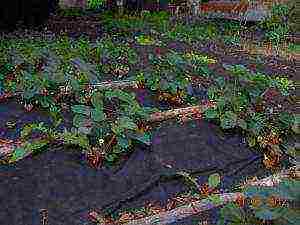 The combined method of mulching will prevent the formation of fungi.
The combined method of mulching will prevent the formation of fungi.
The film is laid on top.
Plain seedlings is planted to a depth of 10–12 cm, and the roots should be cut by 9.
For seedlings with a closed bark system wells are prepared a little deeper, since they are planted in cups.
Leaf rosettes are located above ground level.
Step-by-step instruction
- A sunny spot is prepared and the site is cleared of weeds.
- The soil is dug up with the addition of organic fertilizers.
- The rows are mulched and covered with agrofibre.
- The marking of the seats is done.
- Seedlings are planted in prepared holes, which are made with a round stick. Then the roots will go down well. If the roots turn out to be bent, then they will rot and will not be accepted.
- Before planting, the roots are dipped into a solution of water with potassium permanganate and carefully covered with earth.
- The corners of the canvas are wrapped inward.
- Each bush is watered abundantly.
- The next watering is done in a few days (2-3 days).
- When planting strawberries on agrofibre, drip irrigation is used in the future.
Care rules
Proper care of strawberries will allow you to get high yields:
- Dry and waterlogged soil is harmful for strawberries. In the summer heat, watering, in the form of drip irrigation, is carried out 2-3 times in 7 days. It is advisable to carry out the procedure in the evening. If the days are cool, then the period between watering increases.
- In the first year of life, strawberries are not fed, since the soil received enough nutrients during the organization of the beds.
 Berries on agrofibre are much cleaner than on the ground. The culture is fed with liquid fertilizers, special for strawberries.
Berries on agrofibre are much cleaner than on the ground. The culture is fed with liquid fertilizers, special for strawberries.- The first top dressing is applied in the spring, in the second year of life before flowering.
- A phosphorus-potassium mixture is being prepared: 60 g of superphosphate, 150 g of potassium nitrate or potassium sulfate, humus with water 1: 5. The aisles are watered (for 3 m 1 bucket).
- Such feeding is repeated in the second phase of active development.
- The next organic dressing is applied after picking the berries. Dosage: 10 g of ammonium nitrate per 5 liters of water.
- The third and fourth years are accompanied by inorganic feeding.
- In the spring, old leaves are pruned.
In the summer, the mustache and all foliage are removed, except for young leaves.
Estimated prices
When buying agrofibre it is worth paying attention for density and its manufacturer... Products weighing 50–60 g / sq. Are considered the most in demand. m. The higher the density, the more expensive the fabric.The fabric is offered in rolls from 10 to 1500 m.
The next parameter when choosing a fabric is its color.
On the advice of gardeners, light colors work well for southern regions.
- Agrofibre 60 UV of the Russian manufacturer with parameters 3.2x10 (m), black can be purchased via the Internet for 665 rubles, where, the first number (3,2) indicates the width of the fabric, the second (10) is the length of the roll.
- Agrofibre 50 g / sq. m for strawberries from the Polish producer with parameters 1.6x10 (m) - 150 rubles.
Increasingly, gardeners use agrofibre when growing strawberries. Thanks to the use of polymer material and its unique characteristics, the labor intensity of work on the beds has significantly decreased. When choosing an early berry on the market, preference is given to pure strawberries with an even color and no signs of decay. It is this kind of crop that can be grown using agrofibre. In this article, we will find out which fiber material is better, how to plant berries under it and consider the planting scheme.
What is strawberry agrofiber and what is it for?
The material began to be used not so long ago (about 15-17 years old), but millions of gardeners have already appreciated its advantages. The fabric is made of polypropylene fibers in a non-woven way. The porous structure does not impede the penetration of moisture and oxygen. The composition does not include toxic substances, which indicates the safety of the product, both for human health and the environment.
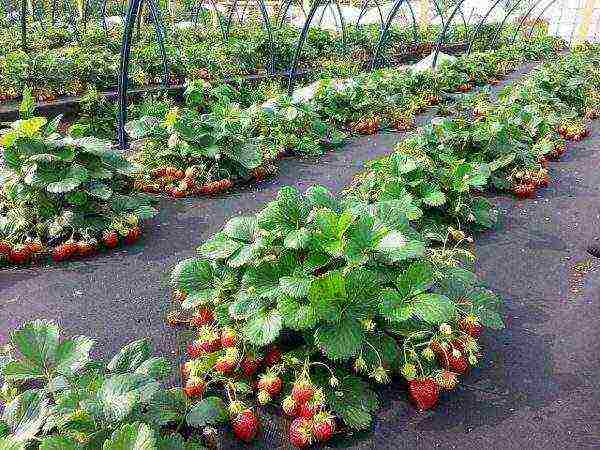 Strawberries under agrofibre
Strawberries under agrofibre
The safety of agrotextiles is due to the polymer composition used for the production of food containers.
Agrofibre is designed for different areas of agricultural activities. The material protects the sprouts from spring frosts on the soil, creates a comfortable microclimate for plants, and prevents the soil from drying out. Weeds do not grow on beds covered with canvas due to opacity, and the thermal conductivity index allows you to insulate the walls of greenhouses that are operated year-round or since February.
Depending on the species, the shelter can be laid on the ground or fixed to the frame, covering the plants from the scorching sun or heavy rains. The textile prevents damage to plants from strong winds or hail. The use of material for greenhouses makes it possible to get an early harvest. Unlike film, textiles freely pass air and moisture, and in price it is quite affordable.
Previously, when growing strawberries, creating comfortable conditions and protection had to be done by mulching. Sand mixed with peat was poured over the soil in the beds, or straw and dry leaves were covered. Obligatory and regular were also considered: watering, loosening the soil, removing weeds. By using agrotextiles, effort and time can be kept to a minimum.
Advantages and disadvantages of using agrofibre when planting strawberries
 Strawberry berry grown from under agrofibre
Strawberry berry grown from under agrofibre
Like any material, agrofibre has its advantages and disadvantages. You need to familiarize yourself with them so that unpleasant surprises do not arise during the process of laying or using.
The pluses of nonwoven fabric include:
- a simple and quick way to lay on the beds;
- the soil is protected from weathering and drying out;
- after watering or rain, the berries will remain clean;
- the lack of contact of strawberries with moist soil prevents the formation of rot or unripe areas;
- you will not have to process the aisles from weeds;
- it is much easier to control the growth of the mustache;
- the number of waterings is reduced;
- the risk of getting a fungal infection decreases;
- berries ripen 2-3 weeks earlier.
To the listed advantages, it should be added that the material is used repeatedly. With careful handling, it retains its qualities for 3-4 years.
The material has few downsides. The first time after the appearance of textiles on the market, its cost was inaccessible to the masses. Now this fact is irrelevant. More significant disadvantages are surface contamination after rain or watering. You can solve the problem by simply washing the canvas with soapy water. When purchasing a product, you should correctly select the density.
With an indicator of more than 30 g / m2, there is a high probability of dew formation on the inner surface, which creates favorable conditions for the spread of various diseases. And one more disadvantage is low strength; under mechanical stress, the canvas breaks through.
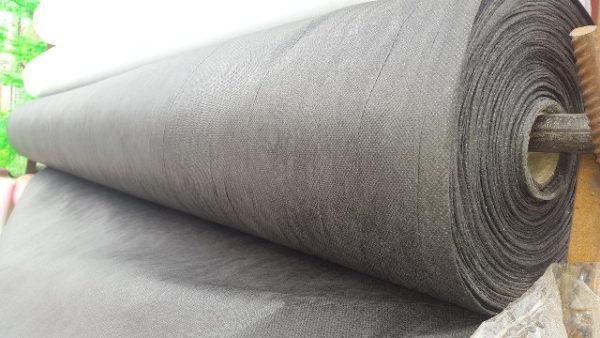 Roll of agrofibre
Roll of agrofibre
Types of agrofibre
Depending on the density indicator, the purpose of the material and its type are determined.
- Textile 17 g / m2, available in white and black, is used as a cover for the beds. It is used to protect crops or crops from frost (up to -2 °), rain, temperature extremes, and the spread of pests. Due to its light weight, the canvas is lined directly on top of the plants, without interfering with their development and growth. Light transmittance is up to 90%. It is not necessary to remove agrofibre for watering, disclosure is provided only during the flowering period for the purpose of pollination.
- Textile 23 g / m2 is designed to protect crops from frost (from -2 ° to -5 °). When laying, it does not require a frame, the canvas lies on top of the beds and is fixed with heavy objects along the entire perimeter. Also, this type is used to insulate the walls of the greenhouse.
- The 30 g / m2 textile protects from frost (down to -7 °), scorching sun rays, wind and torrential rains. The structure of the material is strong, able to withstand snow drifts. The canvases are fixed on a frame (usually curved tubes) or on the trunks of shrubs and trees. This growing technology provides an early harvest (2-3 weeks).
- Textile 42 g / m2 is a durable material that is used for greenhouses and greenhouses. Due to the properties and density of agrofibre, plants are protected from frost (up to -8 °), temperature extremes and unfavorable weather conditions. Covering greenhouses is done well in advance (one week before planting or sowing) to warm up the soil and air. In autumn, the trunks of shrubs and trees are wrapped in linen to protect them from freezing in winter.
- Textile 50 g / m2 does not transmit light, is used as mulch. It is laid on the ground, protecting the beds from weeds, drying out the soil. Wintering with such a shelter prevents crops from freezing.
- Textile 60 g / m2 white is the densest and most durable material used for greenhouses, greenhouses... Prevents freezing of plants at 10 degrees below zero. It transmits light and moisture well, creating favorable conditions for development and growth.
- Textile 60 g / m2 black is intended for mulch, does not transmit light, which prevents the growth of weeds. The material retains heat well, allows air to pass through, and prevents the spread of mold.
Agrofibre is produced in white and black in rolls with a range of widths from 1.5 to 4.2 m.
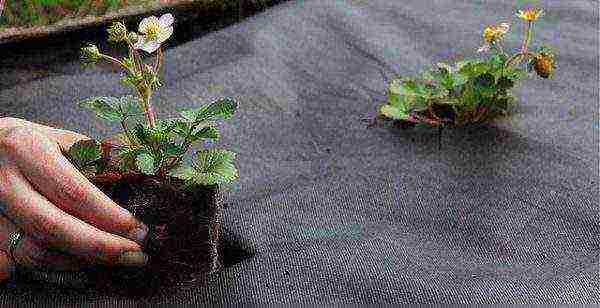 Planting strawberries under agrofibre
Planting strawberries under agrofibre
The higher the density of the agrofibre, the lower the light transmittance.
For mulching strawberries, a Black cloth with a density index of 50 g / m2 is suitable. In difficult climatic conditions, it is recommended to use 2 types of textiles at the same time: white 17 g / m2 for covering over the beds, black 60 g / m2 for laying on the ground surface.
When is it better to plant strawberries using agrofibre: spring or autumn
Strawberries are usually planted in both spring and fall. When using agrofibre, it is preferable to do this in the spring, since all stages of the process are typical for spring gardening work. The planted tubers develop faster and better, throw out tendrils, which can increase the yield next year. And the canvas after wintering does not need to be removed in order to clean it from debris and earth.
The disembarkation period depends solely on the climatic conditions.In the middle lane, this is done from mid-April to early May.
How to properly plant strawberries under agrofibre?
Preparatory process
The first stage is to equip the beds... It is necessary to choose a place for planting strawberries taking into account the good illumination of the sun's rays and the availability of watering. If the garden is embossed, then preference is given to the upper tier in order to protect the roots of the plant from excessive moisture in groundwater. Sloping beds should be leveled by making a reliable support to prevent soil loss.
 Preparing the beds before planting
Preparing the beds before planting
After marking the beds (taking into account the width of the agrofibre), digging and loosening of the soil is performed. In this case, old roots, debris, weeds should be removed. The treated area must be fertilized. For these purposes, you can use humus, wood ash and other mineral fertilizers.
Further, the beds are lined with canvases, the joints are overlapped (at least 20 cm). Along the perimeter, the textiles must be pressed to the ground and fixed with stones or bricks so that the wind does not tear off the created shelter. Additional fasteners are studs made of wire (Ø 6 mm). For this, pieces of 70 cm are cut and bent in half. It is better to install them after planting the tubers, so it is easier to identify invisible zones (for example, between bushes).
How to plant a berry?
The next step is to plant strawberries. Some manufacturers took care in advance by making holes for seedlings on the canvas. If there are none, then disembarkation points are marked on the canvas. It is important to provide enough space between the bushes, but it should also not be large.
Ideally, there should be a distance of 20-30 cm between the holes. The marked places are cut with a sharp knife (the cut is made crosswise with a length of 10-14 cm). In the case of planting tubers with pots, it is recommended to make round holes for easy installation and removal of the plant. The depth of the holes in this case corresponds to the parameters of the pot.
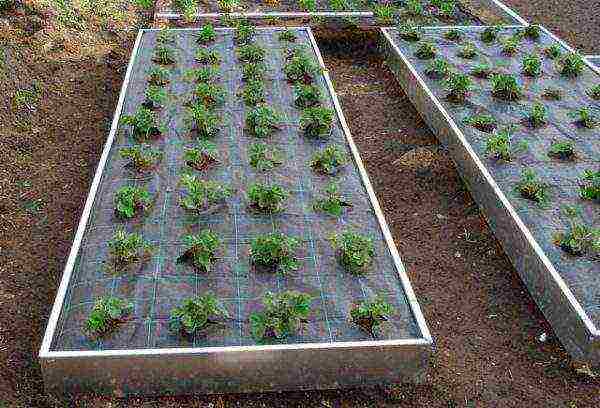 Strawberry bed under agrofibre
Strawberry bed under agrofibre
Seedlings are picked up with developed roots, but not a thick base. There should be at least five leaves without signs of damage. Before planting, it is necessary to keep the tubers in a cool place for 4-5 days.
The planted tubers must be covered with the corners of the cutout and watered well. It is better to do this from a hose with an installed spray. The rain effect will create less dirt on the canvas and provide even moisture to the beds. During the period of seedling survival, it is advisable to spend 0.5-1 liters of water for each bush.
How to water strawberries under agrofibre?
Care for strawberries grown under agrofibre is carried out as usual. It is not necessary to remove the canvas for irrigation, the material passes water well. One of the advantages of textiles is moisture retention in the upper layers of the soil. This is important to take into account so as not to overfill the beds. The usual irrigation regime with covered ground is reduced by a third. The frequency depends entirely on weather conditions. In dry weather, it is recommended to moisten the beds at least once every 5-7 days by sprinkling. Approximately 10 liters of water is used per m2 of land.
The jet from the hose should not be strong, it is necessary to use nozzles that dissect the water. The roots are located at the surface of the soil. With an abundant pressure, the soil will be washed out, depriving the tubers of shelter. The recommended water temperature for irrigation is at least 18 °. Cold irrigation can kill the plant. Most often, a settled liquid is used, in which the content of chlorine and other chemical impurities is minimal.
Spot irrigation is considered no less effective. Such a system provides for the location of the hole on the hose directly at the root system of the tubers. It is easier to track the amount of water consumed and the degree of moistening of the beds with this method. The only drawback is the lack of the ability to wash off dust and dirt from the strawberry bushes.
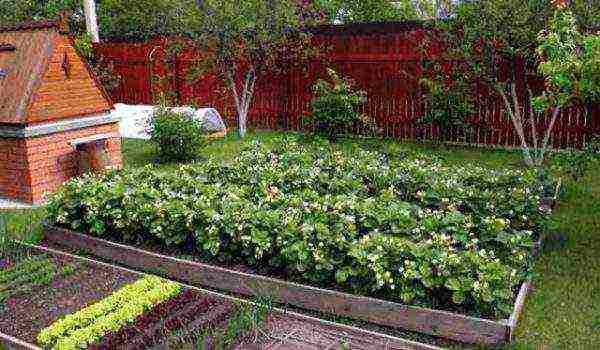 Strawberries growing in formwork under agrofibre
Strawberries growing in formwork under agrofibre
During the flowering period, watering increases to 3 liters per bush (up to 25 liters per m2). But the decisive factor is the degree of soil moisture. If it is moist and loose, which is controlled by retracting the corners of the incision, then the amount of fluid is reduced. When the berries turn red, the need for irrigation decreases, and sometimes irrigation stops for a while. So it will be possible to grow strawberries saturated with flavor notes.
After harvesting, watering until mid-August is carried out as usual (10 liters per m2). This will enable the plant to feed and grow stronger in order to survive in the winter.
Before choosing agrofibre, it is worth considering important factors: purpose, period of use, garden parameters, climatic features. This will allow you to choose the most suitable option, providing an early harvest and easy care. Now you know how to plant and cover your berries!
Everyone who has come across the cultivation of strawberries and other berry crops is well aware of the situation: you need to constantly pull out weeds, loosen the soil and even prevent it from drying out. These actions take up a lot of precious time and effort. Of course, you can't stop watering, but how can you minimize all this? Someone solves such problems by mulching strawberries with straw or other materials. But the consumer of the XXI century has access to a scientific solution to this issue. This is agrofiber (it is also called agrotextile), a type of spunbond. Shelter with this material creates favorable conditions for the growth and fruiting of strawberries. Spunbond is cheaper than agrofibre, but its service life will be much shorter. In this article, we will look at how to choose agrofibre for strawberries, how to care and water after planting.
General characteristics of agrofibre
Agrofibre, unlike plastic wrap, will allow you to freely water strawberry plants, apply fertilizers without removing the cover. This material differs from the well-known film:
- quite lightweight and dense;
- does not fade in the sun;
- inhibits moisture evaporation;
- protects against frost, pests and weeds.
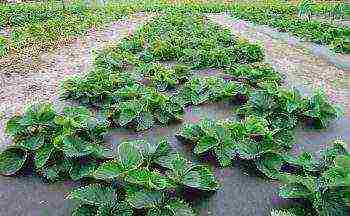
What does a planted strawberry look like on agrofibre?
Also, a big advantage over other types of coatings is its compactness (easy to fold and remove from the garden) and the ability to use more than 2 seasons. It is sold in rolls (from 1.5 to 4.2 m wide) in black and white, and has a density range of 17-60 g / m² (the most important performance characteristic). The higher the density of the canvas, the less light it transmits.
Agrofibre weighing 17 g / m² transmits 80% of the light, and dense 60 g / m² - up to 67%. For mulch, a material from 50 g / m² is suitable (now a density of 80 g / m² has appeared on the market, but this is a different material - agrotechnical). The presence of 4-5% UV stabilizer guarantees the durability of the agrofibre, and the uniform thickness of the web ensures the same temperature in the ground-shelter space.
White agrofiber protects against frost (from -2 to -8 ° С) and wind; black has its purpose to mulch the soil, protect against weeds, and inhibit the spread of diseases. By the way, black is produced exclusively in 50th density. There is the use of white and black agrofibers at the same time (you get rid of weeds and create a positive microclimate not only in the soil, but also on the surface of the site). On sale you will find products from both domestic and foreign manufacturers. Farmers know about the existence of such brands as Agril, Agrotex, AgroSUF, Lutrasil, Agrospan, Spunbond. Depending on the density, the price for this covering material ranges from 10 to 50 rubles per 1 running meter.
🎥 Video advice from Vladimir Parkhomenko "How to choose agrofibre for strawberries"
An illustrative video with examples and advice from Vladimir Parkhomenko on the rules and recommendations for choosing a covering material for strawberries and planting other fruit berries on agrofibre. Combination of mulching and spunbond material ⇓.
Black Agrofibre Shelter
This type of shelter is used as mulch and is the most common. Refers to non-woven polypropylene materials, does not harm either plants or animals. But at the same time it does not allow weeds to grow and inseminate. They perish from the absence of light, strive to break through dense material, but cannot. This covering material will help create the desired microclimate, but not on the surface of the soil, but in the ground itself.
Features of agricultural technology when covered with black agrofibre
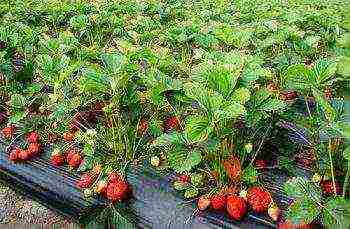
Volumetric yield when growing a plant on agrofibre
If in the strawberry bed, at least occasionally, sow thistle shoots are observedand he belongs to root-sprouting weeds you need to remove it. It is advisable to spray with a special herbicide. Why? Remaining under the spunbond, it will begin to grow and lift the canvas up, and it is not so easy to pull the sow thistle out from under the shelter!
Remember, a lot of heat accumulates under the black agrofibre, which is why there is a risk of overheating the strawberries in the heat. Therefore, after the sun, at sunset, it is imperative to water it.
Shelter in black and white agrotextile
This textile has appeared recently. This is the best choice. In terms of functionality, it surpasses the usual black agrofibre. It is laid with the white side to the sun, and the black side to the ground. Consequently, the light surface will reflect the sun's rays from the strawberries and prevent overheating. The dark side will ensure maximum moisture retention in the soil. This material contributes to the uniform fruiting of berry crops. This option is convenient for farmers in the hottest regions. Its density is 50 g / m²; used only for mulching berry and vegetable crops.
When should you buy white agrofibre?
Such agrofibre with a low density of 17-25 g / m² perfectly protects from excessive sun, heavy rainfall (it will keep the topsoil from washing away), as well as from birds. If you need frost protection, use white fiber (higher density - 50-60 g / m²). It will also protect from hail and even snow, help speed up the harvest by 5-7 days due to faster soil warming.
Unlike the two previously discussed types, white is used as a temporary shelter.
Features of planting strawberries under black agrofibre. Which side to lay?
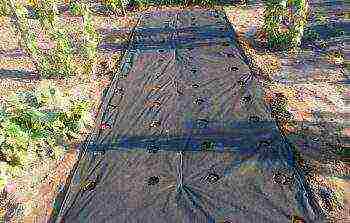
What does a stretched fiber look like for a cut-hole planting?
Planting strawberries with black agrofibre is easy. First, they prepare the site: fertilize, dig up, level with a rake, remove all stones, last year's weeds, roots, branches. Choose a planting scheme (continuous or in rows - one or two contiguous) and the location of the tracks. The width of the latter is selected based on the convenience of moving around the site. Then the fiber is laid out on the bed in accordance with the shape. Each next piece must be overlapped (0.25 m). At the same time, the possibility of fiber getting into the track area is excluded. Otherwise, walking on the coating will shorten its lifespan.
According to the selected scheme, 5x5 cm cross-shaped holes are cut in mulching agrofibre, while the corners are wrapped inward. There is another option for making holes - this is punching them with a meter stick, at the end of which a metal cylinder with pointed edges is nailed (a tin of canned fish with a diameter of up to 5 cm). Strawberries are planted at intervals of up to 30 cm, the distance between the rows is 40-60 cm.
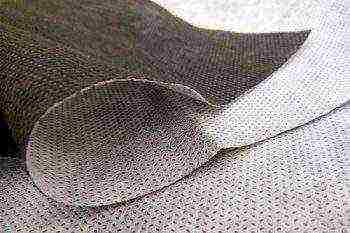
What a close-up black and white material looks like
After planting seedlings, it is boldly watered through such a shelter. Along the edges of the strawberry section, the agrofibre must be pressed to the ground (with slats, rods or stones), and it is better to pin it down with pieces of elastic wire or thin reinforcement.
The described technology involves planting strawberries out of the blue. But on an industrial scale, they practice the use of beds in the form of ridges, which are created by technique or by hand. To cover the ridge with agrofibre, the latter is cut into even parts, while often unused segments remain. The disadvantage of this method of bed-ridges is the fact that during seeding, when replanting strawberries to another piece of land, the old one needs to be leveled for other crops. Although the soil on the ridges will warm up in spring (and the harvest will be harvested earlier), in summer the land dries up faster, in winter it freezes strongly. Therefore it is better grow strawberries on agrofibre out of the blue.
Strawberry care under mulch fiber
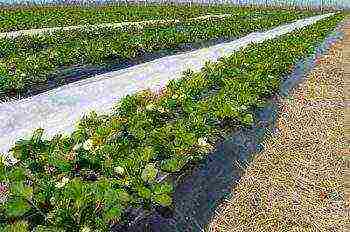
Properly planted strawberries with hay lanes to prevent weeds
Growing strawberries with agrofibre is easier than growing outdoors. Care consists in:
- timely watering (carried out as the earth dries up, once every 3 days),
- top dressing with liquid fertilizer (and only at the root),
- trimming excess mustache,
- fight against diseases.
Water in the evening or morning. If strawberries were planted later (in the fall), then when the first leaves appear, they are fertilized with complex fertilizer or mullein infusion. When planting in spring, they are fed before the appearance of peduncles. It is advisable to fertilize the strawberries after harvest. It is worth noting that in the case of industrial cultivation of strawberries, drip irrigation is used.
Comparison of white, black and black and white agrofibers
| Agrofiber | Application | Impact on the ground | Weeds | Exceptional differences | Required density |
| White | Covering material over landings | Creates a favorable microclimate in the area above the plant and restrains the ingress of cold there | Suppressed slightly | Protects from birds, insect pests, keeps the spread of diseases | 17-60 g / m², depending on expected frost |
| Black | Mulch | Delays
moisture |
Completely suppressed | Prevents soil drying out | 50 g / m² |
| Black and white | Mulch | Delays
moisture |
Suppresses the growth of weeds | Prevents greenhouse effect in the ground-fiber zone | 40-60 g / m² |
Advantages of growing on agrofibre:
- It has been noticed that the plots where agrofibre is used give a higher yield.
- There will be no weathering of soil and moisture.
- There is no need to dig up row spacings.
- When mulching with agrofibre, it is easier for the owner of the site to monitor the spread and growth of the mustache, that is, now a certain order is observed. You can always see which shoots to pull out and which ones to leave for use (root).
- After the rain, the covering material itself is dry, so the berry does not lie on wet soil. It will be clean. For owners of large plantings of strawberries, this is especially important (excellent presentation remains).
- Slugs will not crawl around berries.
- The operating temperature range of agrofibre is from -55 to +90.
- One of the main advantages: you do not need to weed the soil many times, since weeds do not grow under the black material.

Strawberries sprout through the fiber
Concluding the review of the choice of agrofibre for strawberries, it is worth highlighting a few points. Agrofibre combines the properties of mulch and the properties of a covering material. Protects young strawberry shoots from burns, while letting in a sufficient amount of UV rays. Good air and water permeability creates the necessary conditions for plant growth; the material does not accumulate water (when wet, it does not increase its mass). Watering strawberries under agrofibre is carried out directly on top. The strength of the material guarantees a long service life.With careful care, agrofibre retains its technical characteristics for 3-4 seasons. It shortens the time it takes to grow these early berries. You do not need to constantly fight weeds, loosen the soil near the shoots.
🎥 Video analysis from Tatiana "Pros and cons of using agrofibre"
An illustrative video with an analysis of the advantages and disadvantages of using agrofibre and practical recommendations for its use.
Answers to common gardeners questions
Question number 1. What can replace agrofibre? - If as mulch, then either black film, or geotextile, or agrotextile.
Question number 2... Will the use of such a fiber pay off? - Yes, it will pay off, provided the correct agricultural technology and respect for the covering material. After all, it will last more than 3 years.
Rate the quality of the article. We want to be better for you:
The conducted research has determined the list of the best varieties of garden strawberries for the south of Ukraine. It includes the varieties Alba, Honey, Clery, Marmalada and Elsanta, the latter three most often used in production conditions.
First of all, in the open field - already in the third decade of May - strawberries of the Clery variety ripen. A few days later, the Marmalade variety begins to ripen, and the Elsanta variety must be harvested at the beginning of June, which is considered an average period. Regardless of the variety, the harvest will always be good, and the fruits themselves will look beautiful on the outside and have a dense pulp inside. The varieties of Marmalade and Clery, in particular, are distinguished by a delicate aroma, and the taste of such strawberries can be described as sweet and sour. Such strawberries can be transported over long distances without losing the commercial quality of the fruit. When grown outdoors, the Marmolada variety should be avoided cooling delays after harvest, otherwise the quality of the crop will decline.
Choosing the right soil
When growing strawberries, it is important to choose the right place - not all crops go well with it. It is optimal if, before planting the berries, the soil is kept under black steam, which has a beneficial effect on the soil, clearing it of weeds and retaining moisture. If this is not possible, then cereals and row crops can act as predecessors. Worse if it is vegetable crops, and nightshades are completely undesirable.
There are some other restrictions that must be observed when growing strawberries outdoors. So the root layer should not be waterlogged, as well as the content of calcium salts in the soil should not be exceeded. The presence of hydrochloric acid, from which it boils, is a sign that suggests that it is better not to grow strawberries here, so that they do not chlorose.
You should also avoid areas where there is a congestion of cold air - they are called "saucers", they are closed lowlands. Failure to follow this recommendation can lead to the fact that the cold will damage the flowers and ovaries. This is especially worth fearing in the spring.
Soil preparation
It is recommended to prepare the soil in advance - one year in advance. After the site has been freed from its predecessor, it is fertilized. For this, compost or manure is used at the rate of 40 to 60 tons per hectare. Poultry droppings and other concentrated fertilizers are not recommended for normal root growth. The next stage is plowing with a seam turnover, it is carried out at a depth of 25 to 30 cm.
When it comes time to plant in front of her, you need to prepare mulched ridges. Here you can choose the width and height parameters at your discretion, based on the landing pattern. The minimum width, subject to a two-line tape planting, will be 70 cm, the maximum - 120 cm. The height can vary from 15 to 40 cm. As for the width of the tracks, it will be in the range from 60 to 70 cm - it is determined by the width of the track and wheels of the tractor.
Having prepared the soil by milling, ridges are formed.After laying the drip line, the surface is mulched with a film in which holes are made. There must be at least 60,000 plants per hectare.
Planting dates will depend on the selected seedlings. If it is frigo, then planting occurs in the first two weeks of July, if it is green, in the second two weeks.
After planting, you need to take care of sufficient watering so that the soil is always saturated with moisture (60-75% HB) - this is the only way the seedlings will be able to take root. Watered directly at planting and immediately after it.
At the onset of spring, as part of the first field work, you need to process the plants, removing diseased and dried leaves and whiskers. At the same time, strawberries should receive the first nitrogen fertilization - 20 kg a.i. per hectare.
We use agrofibre
Agrofibre is used in mid-late February. The site is preliminarily prepared - old plant debris that can infect seedlings are removed.  The agrofibre is spread so that one canvas covers several ridges at once, securing the sides.
The agrofibre is spread so that one canvas covers several ridges at once, securing the sides.
For fixing, take special pins, or as an alternative, ordinary sandbags can act, or you can use both methods at once.
It is undesirable to open the canvas before flowering. As soon as the first flowers have appeared, and if the weather is warm, in the afternoon, on the contrary, it is useful to harden them, opening and covering them again for the night. This will have a beneficial effect on the pollination of flowers.
It is possible to completely remove agrofibre only when the plants are definitely not threatened by frost. Most often, this period falls at the beginning of May. Having removed the canvas, they process the ridges, removing weeds and mulching the rows between the ridges with chopped straw (layer 7-8 cm) so that the strawberries do not touch the ground.
Harvesting
As soon as the berries begin to ripen, we are preparing for the first harvest, and there will be from five to seven such techniques, and in time they will last for 3-4 weeks. Strawberries are harvested while it is not hot, early in the morning.
When the entire crop is harvested, they wait a few days and mow (trim) the leaves at a height of 5 to 7 cm, followed by their removal. The next stage will be soil treatment with pesticides and repeated application of nitrogen fertilizers. The foliage is then removed.
The term of use of the strawberry plantation, where strawberries are grown, is two years. Having removed the second crop, they take a systemic herbicide to treat the plants themselves and the row spacings where weeds grow. Dried plants can simply be removed or burned with a film, since it is no longer suitable for further use. After that, its remnants also need to be removed.

